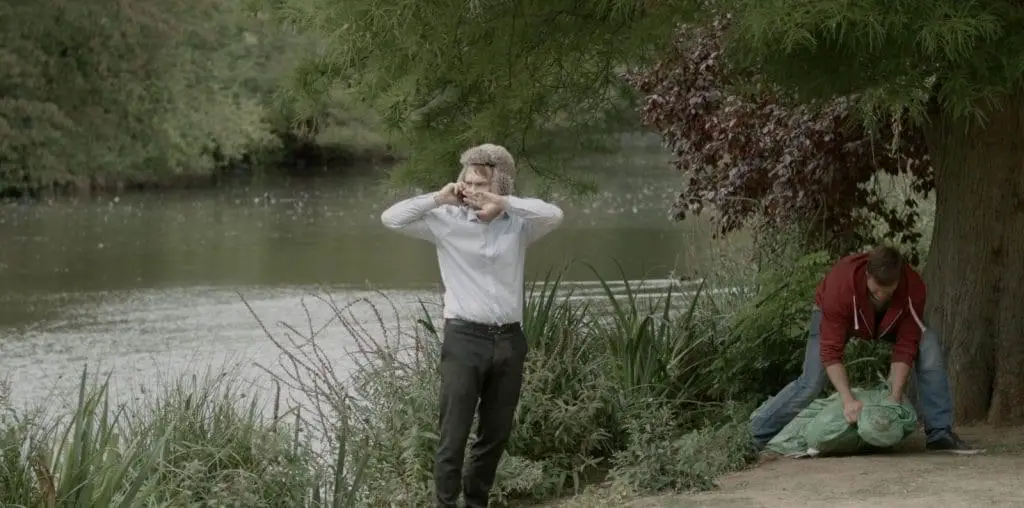
What a difference half a week makes.
Inclement weather marched across Georgia on Good Friday 2009, sending severe thunderstorms throughout metro-Atlanta and a tornado over the northern areas of the state. Meteorological conditions had improved on Easter, and by April 15th, one day before the 2009 Atlanta Film Festival kicked off, it was starting to smell, sound, and feel like spring in the ATL. And so, on a warm and breezy Wednesday afternoon, I met up with writer-actor Gary Weeks at a Korean bakery to learn more about “Deadland,” the film he stars in and wrote. Satiated by coffee (for him) and a honeydew-celery smoothie (for me), we rapped about life, happenstance, and making movies.
Gary was born across the Atlantic Ocean, in Germany, but grew up in the Plains, GA, which is just east of the Alabama/Georgia border. He might have spent his childhood and adolescent years playing football and basketball like the rest of his male peers, but underneath that athletic exterior an imaginative writer thrived. After graduating from the University of Georgia and then completing film school at Georgia State University in 1999, Gary headed westward to the City of Angels to further nourish his inner artist. Per his IMDB page, the ten years he has been in Hollywood has yielded nearly forty acting credits and four writing-producing credits. His most recently completed project is “Deadland,” which had its world premiere on April 18th at the Atlanta Film Festival.
The inspiration for the movie resulted from the overlapping of two factors. Gary and “Deadland” director, Damon O’Steen, wanted to do another project that would be “totally outside the box and up that ante,” something quite different from their first collaboration, “’29 Reasons to Run,’ which was a road-trip comedy.” Primarily filmed in southern Georgia (Quitman County) and California (the National Forest, the Salton Sea) in August of 2007, the premise behind “Deadland” first sprouted when, as Gary recounted, “One day I left my cell phone at home; I was naked without it the whole day. . . all I could think about was going home and getting my cell phone. . . And then I started thinking about how many times in my life I’ve actually felt like that, where the internet’s down and the cable’s out. . . . What would happen if one day we came home and everything was gone. . . and pushed back to how it was 200 years ago, what would you really strive to do, to fight for?”
Entertaining and developing the answer to that “what if” question provided the creative spark for a film that explores the ways in which people confront and persevere in a civilization in tatters following worldwide nuclear devastation. Thematically, “Deadland” posits that surviving isn’t limited to physiological sustenance. Human beings cannot (or should not) rely exclusively on physical well-being. Mental resilience is equally important. Specifically, the rebuilding of civilization requires more than re-establishing political order. Oral tradition, mythology, and folklore are vital in replenishing the morale among the people.
Visually, post-apocalyptic films in the vein of “Doomsday” tend to depict a future that is simultaneously regressive and advanced in terms of technology and social order. These films evoke impressions of a future that one wouldn’t necessarily want to experience. Life in “Deadland” certainly isn’t glamorous, but the way in which the characters — particularly the protagonist, Sean Kalos — exist in it suggests that it wouldn’t be so terrible.
Nodding in agreement, Gary noted that “Deadland” is, broadly speaking, unlike other films of similar settings, because “the post-apocalypse is the secondary part of that common aesthetic — it’s not what the movie is all about. The movie is really, strangely enough, a love story at heart. It’s a guy looking for his wife — that’s the movie.”
Gary further explained that the reason the plot properly begins “‘five years after’ and not ‘the next year’ is that things have sort of gotten settled in; people have started to learn how to survive in that environment. Although there is still disease, they’ve come up with something to be able to handle it and keep it from spreading too much. . . . It’s survival of the fittest.”
Considering how intimately he must have regarded the characters of Sean and his wife Katie (played wonderfully by Emily-Grace Murray) during the writing stage, it’s not too surprising that Gary would end up playing the protagonist. Shortly after confessing to being a romantic, he remarked that he chose to star in the film because he wanted “to play something that’s gonna really be believable and something” he “could really feel.”
The rest of the main cast (such as Brian Tee, Philip Boyd, Chad Mathews, and Emily-Grace Murray) had worked with Gary before or knew him through mutual friends. William Katt (of The Greatest American Hero fame), who plays Shiv, a zany loner whose expertise in code-breaking supplies Sean with very valuable information, was recommended by a casting agent. Executive producer Rick Kelly was also instrumental in bringing together extras as well as crew members for the scenes that were shot in Georgia.
By the time Gary had finished his coffee and I my honeydew-celery smoothie, approximately ninety minutes had elapsed, and we prepared to delve back into the afternoon traffic in our respective cars. Even if years go by before I get to cross paths with Gary Weeks again, I was fortunate enough to have had the pleasure in learning about his endeavors in one of the most competitive industries. More importantly, though, it was amazing and uplifting to glimpse the kind of spirited luminescence that only radiates from someone who truly loves what they do for a living.
